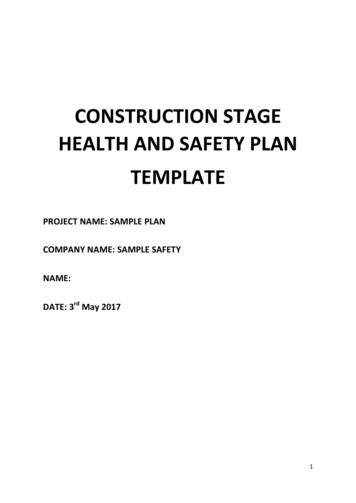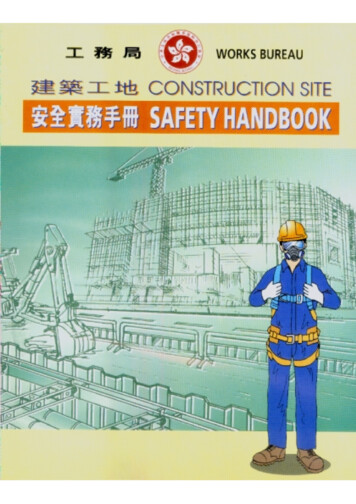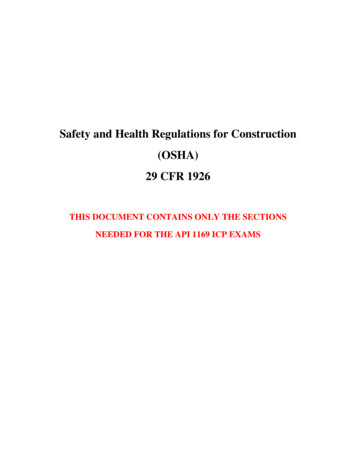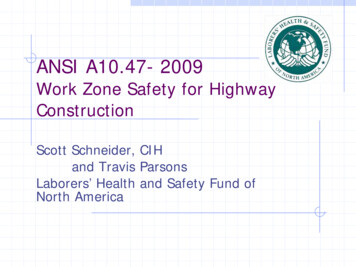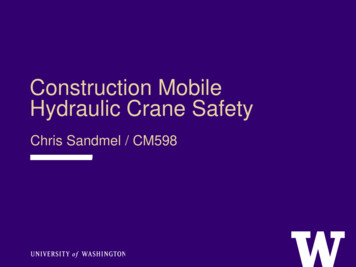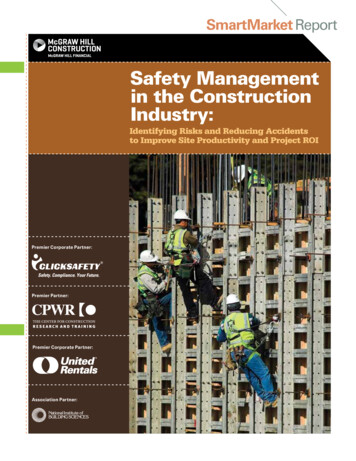
Transcription
DESIGNING FOR CONSTRUCTION SAFETY – ACONSTRUCTION MANAGEMENT APPROACHRizwan U. Farooqui, Ph.D. Scholar, Department of Construction ManagementCollege of Engineering & Computing, Florida International University, 10555 WestFlagler St. #2952, Miami, FL 33174, US, A, Tel: (305)-348-3172, Fax: (305)-348-6255,rfaro001@fiu.eduSyed M. Ahmed, Associate Professor & Graduate Program Director, Associate Editor,ASCE Journal of Construction Engineering & Management (JCEM), Department ofConstruction Management, College of Engineering & Computing, Florida InternationalUniversity, 10555 West Flagler St. #2952, Miami, FL 33174, USA, Tel: (305)-348-2730,Fax: (305)-348-6255, ahmeds@fiu.eduNida Azhar, Lecturer, Department of Civil Engineering, NED University of Engineeringand Technology, Karachi, Pakistan, Tel: (92-21)-9261261 ext. 2205, Fax: (92-21)9261255, nidaazhar ned@hotmail.comABSTRACTStudies have suggested and confirmed that designers can provide critical input involvingconstruction worker safety. Continued progress is being made in the areas of educationand training to better serve all participants in the construction industry, including owners,designers and contractors. Construction management has also become an acceptable andgrowing profession as it serves to address constructability issues through the sharing ofinformation among all participants in the project. This paper offers a constructionmanagement (CM) approach to designing for construction safety by proposing astructured CM approach to information sharing and project collaboration for constructionsafety. The proposed structured CM approach has been developed based on the findingsof a structured survey targeted to design and CM professionals in the constructionindustry.Keywords: DFCS, Construction Management, OSHA1. INTRODUCTIONDesigning for construction safety entails addressing the safety of construction workers inthe design of the permanent features of a project. The design defines the configurationand components of a facility and thereby influences, to a large extent, how the projectwill be constructed and the consequent safety hazards (Gambatese, 2000). For example, adecision would have to be made at the site concerning fall protection. This leaves openthe possibility of a fall injury if inadequate fall protection is used, workers are not trained,or if fall protection is not used at all. If the designer specifies a 42 inch high parapet wall,130
not only does the design comply with the building code (safe for the public), the risk of afall injury during the lifetime of the structure is eliminated because fall protection wouldnot be required. Many other suggestions for how to design the permanent features of aproject to facilitate safety during construction have been documented (Gambatese et al.1997).Studies by Whittington et al. (1992) and Suraji et al. (2001) reveal that a significantnumber of injury accidents originate from conditions upstream of the constructionprocess during planning, scheduling, and design. Though the impact of the design onconstruction safety is evident and the potential benefits of its implementation areapparent, widespread application of this concept in the United States constructionindustry is currently lacking (Gambatese et al., 2005). Designing for safety has beenproven to be a viable intervention in construction in the United States (Gambatese et al.,2005)This paper offers a construction management (CM) approach to designing forconstruction safety by proposing a structured CM approach to information sharing andproject collaboration for construction safety. The proposed structured CM approach hasbeen developed based on the findings of a structured survey targeting design and CMprofessionals in the construction industry.2. DESIGNING FOR CONSTRUCTION SAFETY – THE NEEDDesigners are generally assumed to be responsible for the deign of a building or structure;that meets the local building codes, takes into account accepted engineering practices andis safe for the public. Although typical contract terms do not define designers as beingresponsible for the safety of construction workers, all designers should feel an ethicalobligation to take action to prevent a serious injury to a construction worker if the hazardwas imminent and obvious to them. As accepted by all, decisions made by designersaffect the cost, quality and duration of a construction project. Similarly, constructionsafety can also be enhanced greatly by their prompt input. The quality managementprinciple that quality must be “designed in” also applies to safety: safety must bedesigned into a project.In addition, studies have shown that design professionals can have a significant influenceon construction safety; 22% of 226 injuries that occurred from 2000-2002 in Oregon, WAand CA were linked with the design, 42% of 224 fatalities in the U.S. between 1990-2003were linked with the design (Behm, “Linking Construction Fatalities to the Design forConstruction Safety Concept”, 2005). In Europe, a 1991 study concluded that 60% of thefatal accidents resulted from decisions made before site work began (EuropeanFoundation for the Improvement of Living and Working Conditions). These statisticsclearly suggest that design professionals can play their part in construction safety byincorporating design elements that provide safety for construction workers duringconstruction and maintenance projects.131
Recognizing the importance of the design to construction safety, the American Society ofCivil Engineers (ASCE) states in its policy on construction site safety (Policy StatementNumber 350) that engineers shall have responsibility for “recognizing that safety andconstructability are important considerations when preparing construction plans andspecifications.”Outside the United States, the European Union mandates consideration of safety in thedesign (CEC 1992). The United Kingdom’s Construction (Design and Management)Regulations (HMSO 1994), established to comply with the EU Directive, place a duty onthe designer to ensure that every designer should, while preparing or modifying a designwhich may be used in construction work in Great Britain, avoid foreseeable risks to thehealth and safety of any person likely to be affected by such construction work; and in sodoing should give collective measures priority over individual measures (MacKenzie etal., 2000). Similarly, many other developed countries such as Australia (Bluff, 2003) andSouth Africa (Republic of South Africa, 2003) have already incorporated responsibilitiesfor designers for construction safety. Lacking a regulatory mandate, as is the case in theUnited States, implementation of the concept in practice will likely depend on thebenefits received from designing for safety compared to the effort and resourcesnecessary for its implementation.A requirement of incorporating safety into the design stage of a project to enhanceconstruction worker safety has been proposed (Gambatese et al., 2005) as an additionalmeasure in providing better construction worker safety and health and is commonlyreferred to as designing for construction safety (DFCS). This concept of thinking throughthe risks associated with various means and methods of construction, as dictated by thedesign, can produce positive results in both safety related claims and reduced projectcosts.3. DESIGNING FOR CONSTRUCTION SAFETY – OSHA REGULATIONSIn a research study conducted by Gambatese, Hinze, and Behm (2005), designsuggestions were developed that can ultimately be addressed in the design documents.Contained within the research findings are numerous constructability safety measures thatcan be undertaken, many of which have been developed from those directly exposed tohazardous construction work. OSHA has language within its regulations that refers to theengineer of record providing designs with construction worker safety in mind. Subparts Lthrough X of the OSHA regulations have been identified as areas where the greatestinfluence can be placed to incorporate safety design modifications.Examples of such suggestions are as follows; in Subpart M – Fall Protection 1926.501,Design windowsills to be 42 inches minimum above the floor level. Windowsills at thisheight will act as guardrails during construction. OSHA Subpart 1926.502 suggests thedesign of perimeter beams and beams above floor openings to support lifelines (minimumdead load of 5400 pounds.). It also states to design connection points along the beams for132
the lifelines. The contract drawings should note which beams are designed to supportlifelines, the number of lifelines, and the locations along the beams.Currently, most of OSHA’s construction regulations require engineering controls inSubpart P (Excavation), Subpart L (Scaffolds), and Subpart R (Steel Erection) amongothers. These are a few areas that if addressed in the design stage can explicitly aid inconstruction worker safety through the OSHA regulations.4. DESIGNING FOR CONSTRUCTION SAFETY – LEGAL CONCERNSThe traditional construction industry model has been split into two distinct fields, designand construction. As the industry moved from the master builder system into morespecialty fields, definitions were developed in dealing with standards of practice,construction scope and defining areas of risk. Legislative proceedings were undertaken inthe late 1980’s to introduce bills in support of placing responsibility for safety on thedesign professional, along with the constructor through the use of a competent person onsite to oversee worker safety. DFCS is not attempting to place blame on the designer butrather to bring to the forefront the ethical practice and the value of implementingconstruction worker safety through design efforts.Designing for safety relies on the integration of construction process knowledge and theincorporation of proven methods into the design. Architects and engineers are notprepared to address this deficiency and lack proper training and fear exposure to legalproceedings as a result of injuries due to their designs.Exposure to liability remains the greatest challenge in persuading designers to take ongreater responsibility. Courts have found designers liable for the deaths of constructionworkers based on their prior knowledge of risks associated with different types ofconstruction (Loulakis and Shean, 2005) . Ultimately contract language should reflectthat designing for safety was a strong consideration for the project in question; however,safety remains the responsibility of everyone.The American Institute of Architects rule 2.105 requires that architects take action whenan employer or client makes a decision that may adversely affect the safety to the public,but this obligation is restricted to the completed facility. Similarly, the National Societyof Professional Engineers clause holds the engineer responsible for the safety, health andwelfare of the public in the performance of their professional duties. In summary courtdecisions have gone both ways and continue to be challenged.5. DESIGNING FOR CONSTRUCTION SAFETY – A CONSTRUCTIONMANAGEMENT APPROACHConstruction management can assure project success under various delivery methods.CM is distinct from both design and construction and well recognized as a specialized133
profession. Through the CM model, resources of various disciplines and backgroundsconverge to provide construction leadership in the planning, design and constructionphases. Due to project delivery constraints; timing, project capitalization, ownerexperience, and the complex nature of projects, the CM can serve as an agent to theowner and/or consultant in the pre-design and design phases.Constructors in the CM model can greatly influence and contribute to DFCS through theflow of information as shown in the modified Figure 4. Project knowledge, riskassessment, design reviews, constructor input and a comprehensive management plan canprovide the optimal mix of project safety designs. As will be discussed in the proposedCM model for DFCS, CM offers the best placement of safety assessment andidentification in creating a successful and timely project.In studies conducted by Szymberski (1997), the time/safety influence curve wasdeveloped to demonstrate that designer influence could be an integral part of constructionsafety. As shown, safety can be best controlled during the early stages of the designdevelopment when the influence is high, even as the project is being conceptualized, anddiminishes throughout the project life cycle.Regardless of the chosen contract form or project delivery utilized, design-bid-build(DBB), design-build (DB), or construction manager/general contractor (CM/GC) evengreater influence can be achieved in the conceptual design phase through theincorporation of the experiences of construction management. The earlier thatconstruction management is on board a greater influence can be placed on the effectiveinfluence on safety and vice versa. This concept holds true for all related professionals onthe project, as the influence on safety decreases with project evolvement, as suggested bySzymberski. Fig. 1 represents the Time / Safety Influence Curve (Szymberski, 1997).HighConceptual DesignDetailed EngineeringAbility wProject ScheduleSource: Szymberski 1997Fig. 1: Time / Safety Influence Curve (Szymberski, 1997)134
There are practical reasons for each party participating in a construction project toencourage DFCS, in addition to ethical responsibilities. Subcontractors and generalcontractors that self-perform work have several practical reasons to encourage DFCS: itreduces accident rates, thereby reducing workers’ compensation insurance rates, andincreases project productivity. Benefits to owners from reducing the risk is that one ormore construction accidents cause delays in project completion and hence loss ofprofitability. Owners incorporating Owner-Controlled
DESIGNING FOR CONSTRUCTION SAFETY – A CONSTRUCTION MANAGEMENT APPROACH Rizwan U. Farooqui, Ph.D. Scholar, Department of Construction Management College of Engineering & Computing, Florida International University, 10555 West Flagler St. #2952, Miami, FL 33174, US, A, Tel: (305)-348-3172, Fax: (305)-348-6255, rfaro001@fiu.edu




